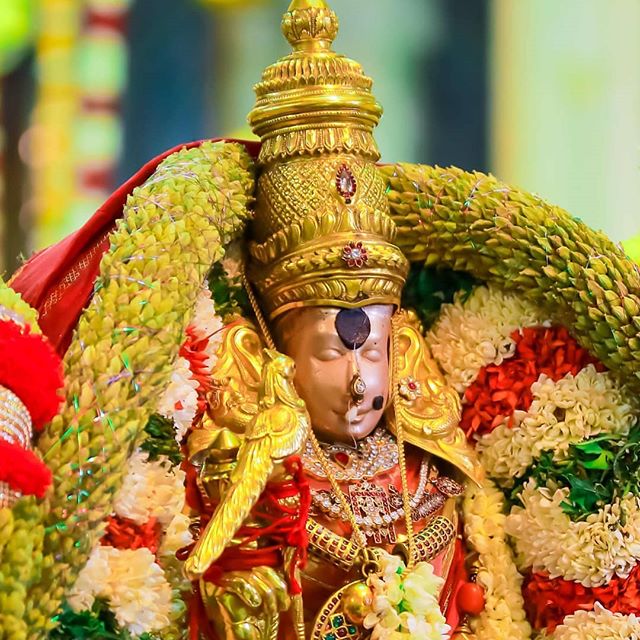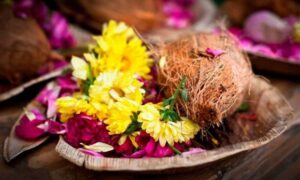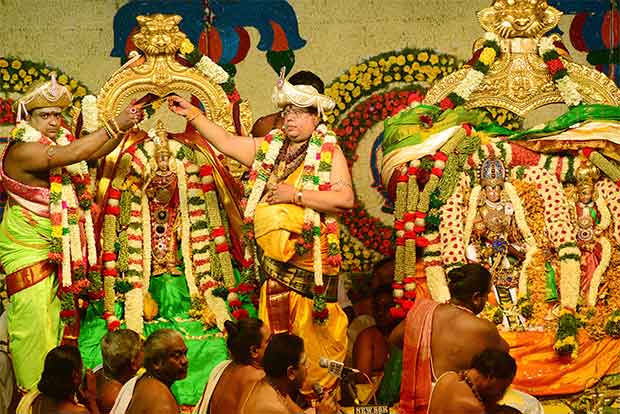मीनाक्षी पञ्चरत्नम् – उद्यद्भनुसहस्रकोटिसदृशाम् केयूरहारोज्ज्वलां
You can book a puja online.
We will send you puja and prasadam from Madurai Meenakshi Temple.
We are here to perform puja’s on your behalf:
We understand that you may not be able to visit the temple personally. Don’t worry we are here for you. We will perform the puja on your behalf and send you the prasadam from the temple. We take care and ensure that we:
- Follow prescribed rituals while performing pujas
- Inform you in advance about date and time of puja so you can meditate at home and connect at a spiritual level
- Ensure that the prasadam reaches you safely
- Will clarify all your doubts and help you in any way we can.
Get blessed with peace and prosperity
It will not be an exaggeration if we say that the Madurai Meenakshi temple represents the heart of the Hindu spirituality in South India. This temple has a vibrant and rich history and is renowned for granting devotees all the boons they desire.
The world renowned Meenakshi Sundareswarar Temple popularly known as the Madurai Meenakshi Temple dedicated to Goddess Parvathi and Her consort Shiva (called Sundareswarar here) stands on the banks of the Vaigai river in the 2500-year-old temple city of Madurai. Legend has it that the king of Gods, Indra, discovered a scared Suyambulingam at Kadambavanam and later enshrined it in the city of Madurai.
Thirugnanasambandar, the famous Saiva Saint, pays homage to Parvathi (whom he calls Aalavai Iraivan) seated in this temple. In fact descriptions of this temple appear in Tamil literature over the last two millennia. Mother Meenakshi has many names as Pachai Devi, Maragathavalli, Thadathagai, Abishekavalli, Abhiramavalli, Kayarkan Kumari, Karpooravalli, Kumari Thurayal, Komagal, Sundaravalli, Pandipiratti, Madurapuri Thalaivi, Manickavalli, Mummulai Tiruvazhumagal.
Muslim invaders from in the early 14th Century (1310) ransacked the temple and the Nayaka kings took the initiative to reinstall the glory of the Madurai Meenakshi temple. The present structure was built between 1623 and 1655 CE. Sundareswarar and his fish eyed spouse Meenakshi are enshrined in twin temples. Enclosing these two shrines are the four huge gateways. This feature can only be found in a few other temples in Tamil Nadu. The city of Madurai was also redesigned as per the rules of architecture (Shilpa Shastras) and constructed in a square shape with its concentric streets finishing at the temple.
The legend behind Madurai Meenakshi Amman temple
Several thousand years ago a pious king called Malayadwaja and his wife queen Kanchanamalai were childless and longed for a child. They performed a yagna and from the fire of the yagna there came out a beautiful girl. They called her Meenakshi which means the one with beautiful fish shaped eyes. There is also another story behind this name. It is said that a fish never closes it eyes. Similarly, Meenakshi Amman protects Her devotees with her beautiful fish shaped eyes that she never closes; She does it by bestowing a kind glance on them.
This girl, Meenakshi was none other than Goddess Parvathi, who had taken a human form. When she emerged from the fire, she had three breasts and the king and queen were very perplexed. However, the received a divine commandment telling them not to worry. The commandment they received asked the royal couple to raise the girl as a brave warrior – just as they would have raised a son. It was predicted that she would lose her third breast when she met her husband.
Meenakshi was a very brave girl and took part in many battles. She also conquered vast regions for her father. Kind Malayadwaja soon named Meenakshi as his heir. Once when Goddess Meenakshi, the warrior Goddess went to war in North India she encountered Lord Shiva who Lived on Mount Kailash.
The minute she laid Her eyes on him she was smitten and became shy, and as predicted her third breast fell off. Her marriage with Lord Shiva (who was called Lord Sundareswarar in Madurai) was finalised and the both of them ruled the kingdom of Madurai for many years. After this they both assumed their divine forms and resided in the Madurai Meenakshi temple as Meenakshi Amman and Lord Sundareswarar (Parvathi and Lord Shiva)
The Temple Architecture
The Madurai Meenakshi Temple is one of the largest temples in India and is an architectural wonder. Spread over 14 acres this temple has 4 majestic Raja Gopurams that tower over the city and form a spectacular feature in the sky line. Each of the gopurams have hundreds of intricately carved idols on them.
Apart from these raja gopurams there are 10 other towers that are present in the temple. The presence of the towering structures serves as a reminder to us of our own mortality and smallness in the large scheme of the universe.
The Madurai Meenakshi Amman temple has also withstood the test of time. Each passing dynasty has contributed to the architecture of the temple and as a result you will find that various styles have been assimilate din the temple.
There are an estimated 33,000 sculptures that are within the corridors, halls and shrines of the temple. The gopurams too have several hundred sculptures in various poses. These have been restored and, in many cases, natural dyes have been used. Many painting and inscriptions can be found on the walls that talk about the history and the glory of the temple.
There is a sacred pond (Potramarai Kulam) inside the Meenakshi Amman Temple that measures 165 ft by 120 ft. The is usually visited before entering the temple. One of the main attractions is the Thousand Pillar Hall (actually there are only 985 pillars!!) These beautifully carved pillars were built by Ariyanatha Mudaliar in 1569.
Currently this 1000 pillared hall houses a museum and on display is several artifacts that have been collected since the 8th century. There are the Musical Pillars outside this hall towards the west. Each pillar produces a different musical note when struck.
Festivals
There are festivals celebrated at the temple every month however the Chithrai Thruvizha in April-May is the most important one. This festival includes the wedding of Meenakshi Amman to Lord Sundareswarar. Other aspects of the festival are as follows:
- Day 1: Flag hoisting, official start of festival
- Day 8: Coronation of Meenakshi Amman
- Day 9: Procession of the goddess
- Day 10: Celestial wedding (Thirukalyanam) of Goddess Meenakshi and Lord Sundareswarar
- Day 11: Chariot procession (Ther Thiruvizhah)
- Day 12: Float procession (Theppa Thiruvizhah)
- Other festivals include Navarathri in September-October, Aavani Moola festival in August-September, Thai float festival in January-February, Aadi Pooram in July-August, Pongal in January-February, Deepavali, Tamil and English New Year days and Vinayaka Chaturthi.
Information about Daily Puja Schedules:
| Puja Name | Days | Time |
| Thiruvanandal pooja | Morning | 05 : 00 AM – 06 : 00 AM |
| Vizha pooja | Morning | 06:30 AM – 07 : 15 AM |
| Kalasandhi pooja | Morning | 06:30 AM – 07 : 15 AM |
| Kalasandhi pooja | Morning | 06:30 AM – 07 : 15 AM |
| Thrikalasandhi pooja | Morning | 10:30 AM – 11:15 AM |
| Uchikkala Pooja (Noon Pooja) | Morning | 10:30 AM – 11:15 AM |
| Maalai pooja | Evening | 04:30 AM – 05:15 AM |
| Ardhajama Pooja (Night Pooja) | Night | 07 : 30 PM – 08 : 15 PM |
| Palliarai pooja | Night | 09 : 30 PM – 10 : 00 PM |
Tips and rules for visiting the temple
- Parking can be very challenging especially during the tourist seasons and other public holidays. Plan well in advance
- Don’t wear revealing clothes that expose too much skin. Wear clothes that cover your legs and arms completely. Advisable for women to wear shawls. The temple authorities are very strict about the dress code so do make sure you are conservatively dressed.
- Leave your footwear and socks in your car or bus. You can’t wear it in the temple premises
- Mobile phones, cameras, electronic items, sprays of any kind, hand bags, backpacks wrist watches, calculators etc. are not allowed. Remember to leave them behind. If you still happen to have them with you, you will be forced to leave them behind in a locker near the entrance for a nominal fee.
- Remember the gate through which you are entering. The temple is very large and has several towers, if you do not remember the gate through which you are entering there will be considerable confusion later if you need to collect your belongings from the cloak room/locker
- Archanai items are available outside the temple and should be purchased beforehand
- Foreigners and non-Hindus are allowed to move around freely in the temple complex but are not permitted to enter the inner sanctum of either the Meenakshi Amman shrine or the Shiva shrine.
- Management of devotees is done professionally and all devotees have to stand in queue for darshan. There is absolutely no need to approach the touts who will approach you at the entrance. However, if you are curious to know more about the local history of the temple you will find some guides who can show you around.
- There are different tickets for special darshan (Rs.100/- for Amman and Shiva shrines and Rs50/- for any one shrine) and normal darshan (free for Indians). The difference between the two is that in special darshan the queue will be shorter and the normal darshan queue will be longer. No tickets for children up to 10 years of age. The price of a special ticket also includes one prasadam laddu.
- Extra prasadam can be purchased at several prasadam counters.
- As a special and unique service to small children, hot boiled mils is provided free of cost to children below three years of age
- Foreigners will have to pay Rs.50/- to enter the temple premises
- Annadanam for 500 devotees is available every day at the temple
- This is one of the primary temples for Shakta devotees and they visit the temple during December and January. This is also peak time for foreign devotees. The crowds will be higher during these two months.
- The city gets very hot and dusty during summers; stock up with plenty of fluids and remember to stay hydrated.
- Every Friday evening Meenakshi Amman and her consort Lord Sundareswarar are seated on a swing and slowly rocked. This is a way to celebrate the love between Shiva and Skakti. During the months of April/May the Thirukalyanam – or marriage ceremony between Meenakshi Amman and Lord Sundareswarar is celebrated in a grand and ceremonial manner.
Special advice: If you are visiting the temple as a devotee and not as a tourist then visit the temple as early as 5:30am or 6:00am. The people who visit at these timings are devotees who come to offer worship and not tourists. As the day proceeds the tourists take over and the whole atmosphere of the temple changes to something more commercial.
We have received many complaints from devotees that the priests at the temple are sometimes corrupt and demand a lot of money to perform archanai’s. Unfortunately, one cannot deny that such behaviour from the priests do happen. If this makes you uncomfortable the kindly pray to God and do not offer any archanai’s – just drop the money you want to offer into a hundi.
Temple Timings:
Temple opening hours 6.00am -12.30pm and 4.00pm to 9:30pm.
Reaching the temple:
- By air – Madurai has an International / Domestic airport with fairly good facilities.
- By train – There is a centrally located railway station in Madurai. Train connectivity is excellent with trains coming in from Chennai, Bangalore, Mumbai and even Delhi.
- By road – Madurai is situated on National Highways NH-7, NH-45B, NH-49. Almost all of them are presently being upgraded to multi-lane ways as part of National highway development program. Travel from Chennai and Bangalore will take approximately 8-10 hours.
- Bus – The city is well connected by buses to all major cities in Tamil Nadu via state government operated and private buses. Buses also ply from important cities in the neighbouring states of Kerala (Ernakulam, Trivandrum) and Karnataka (Bangalore, Mysore). There are lots of ordinary buses and many luxury ones too. Madurai has several bus stands. Most inter-state and overnight buses terminate at Mattuthavani Bus stand. Private buses are found closer to the city centre near Periyar bus stand. Ticketing and reservation facilities are available at the bus-stands.
Address:
Sri Meenakshi Sundareswarar Temple, Madurai – 625 001.
If you cannot visit the temple personally you can order puja by clicking here:






